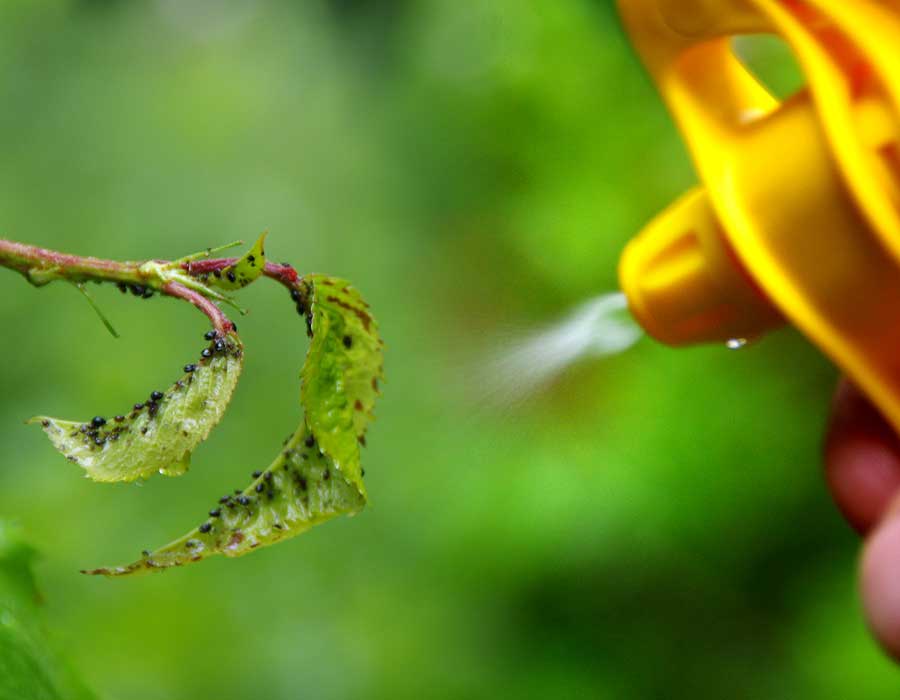How to Get Rid of Aphids on Hibiscus (Step by Step Guide)
Seeing your plant bloom is a delight, particularly if it is as beautiful as the Hibiscus shrub. Unfortunately, however, your attention isn’t the only thing this plant is good at getting.
Aphids on hibiscus are a common problem and, if left untreated, will destroy your shrub. Luckily, there are numerous methods to get rid of these insects.
This article will walk you through a step by step guide on how to deal with aphids, including their identification, elimination methods, and how to prevent the pest from occurring again.
Let’s dig in!
Step 1: Look For the Signs
Identification of the problem is the first step to treatment. If your hibiscus displays any of the following signs, you may have an aphid infestation on your hands.
- Your plant may no longer have the vigor it used to.
- You’ll see a decrease in the number of branches and flowers. In addition, the branches and flowers the plant does manage to grow will be smaller.
- You’ll notice leaf curling and distortion. Leaves may also turn brown and fall.
- The shoots may be stunted and deformed. Plus, they won’t grow to their standard size.
- Your plants may have sooty mold. This fungus grows on honeydew, a sticky liquid that aphids secrete.
- You’ll see clusters of insects feeding on the nutritious juices of plants (more on that later).
- You may see a lot of ladybugs. Since ladybugs prey on aphids, ladybug activity increases around infested plants.

Step 2: Identify the Aphids
In addition to the symptoms mentioned above, it is essential to know what aphids look like to identify them.
Aphids are tiny insects measuring 6/100 of an inch. They are pear-shaped and found in various colors ranging from yellowish-green to green-black. This color spectrum allows them to camouflage themselves into the plant they are feeding on.
You may notice some with transparent wings, but most are wingless. Aphids have tube-like structures called cornicles projecting from their abdomen. This feature is the distinguishing characteristic of the insect. They also have two sucking and piercing mouthparts and three pairs of legs.
These bugs occur in clusters; they rapidly reproduce, forming new colonies. The insects use their mouthparts to feed on the plant sap.
Aphid clusters typically occur inside the leaves and on new growth, particularly in flowers. However, these insects feed on stems and roots as well.
Step 3: Get Rid of Aphids on Hibiscus
If you believe there are Aphids on your Hibiscus, no need to worry! These are common pests that you can get rid of and save your plant. Here are a variety of methods for you to try.
Flush With Water
This is perhaps the simplest way to remove aphids from your hibiscus plant instantly. Use your garden hose and directly target the area where you see the insect clusters. This will ensure you dislodge as many aphids as possible.
Flushing your shrub with water will kill the pests in two ways:
- Some will die immediately due to the high water pressure of the hose.
- Others will fall off. Because they move very slowly, they won’t be able to reattach themselves to the plant and eventually die of starvation.
Ensure your shrub gets a good wash every couple of weeks (or as needed) to prevent infestation.

Oils
If water sprays aren’t working, you may want to switch to oil. You can either use petroleum-based oils or plant-based ones like neem or canola. The oils kill the aphid by smothering it.
Prepare your spray by making a 1-2% oil solution in water and spraying it on your shrub. This technique is particularly effective against winged aphids which escape the water spray.
For this technique to work, you need to cover the plant thoroughly and spray the oil on the infested foliage. Repeat application every 14 days until the aphids are no longer seen.
Since oils can eliminate beneficial insects too, be careful when using the spray and try to target the aphids only.
Insecticidal Soap
Insecticidal soap works the same way as oil. It is made of soap salts that smother the aphids and kills them. You can either purchase insecticidal soap or make one at home.
Most people prefer the former since all the ingredients are mixed in the right proportions, minimizing plant damage risk. However, if you want to make it yourself, you can do that by using the following steps.
- Add 2-½ tablespoons of liquid dish soap and 2-½ tablespoons of vegetable oil (coconut oil will work too) to one gallon of distilled water.
- Give it a good mix.
- Pour as needed in a spray bottle and shake to mix again.
- Coat the shrub in all the infested areas. Repeat every 14 days, and will you see results.
Again, remember to target only the aphids as this spray can also be harmful to other insects.
Use Aphid-Attracting Plants
This may sound like the opposite of what you’re trying to achieve, but it is an effective way to keep aphids off your hibiscus and isolate them.
Aphids find some plants such as nasturtium and sunflowers more delicious and more appealing. You can grow these plants next to your hibiscus, and you’ll see a decrease in aphids on your shrub.
Aphid-attracting plants are often more robust and can take aphids without any damage. Once you notice the pests have shifted from your hibiscus onto one of these plants, you can spray and remove them altogether.
Because these plants can help you get rid of Aphids by “trapping” them, they are also called trap plants.

Pyrethrum Spray
If soaps and oils are not working, it’s time to step up to Pyrethrum spray. These are natural sprays made from dried blossoms of Chrysanthemum. The spray targets the insect’s nervous system, paralyzing it and killing it.
Pyrethrum is available in powder form, but it is recommended to use it in liquid form. You can make your spray by mixing a tablespoon of pyrethrum into a pint of rubbing alcohol. Give it a good mix and transfer the solution to a spray bottle. Then, spray on the insect clusters.
This insecticide is harmful to many insects; therefore, exercise caution.
Diatomaceous Earth
The sharp edges of diatomaceous earth powder work by slashing the insect’s exoskeleton, causing moisture to escape. As a result, the bug dehydrates and dies.
You can use diatomaceous earth against aphids by sprinkling the powder on the soil. You can also brush the leaves and other infested areas with this powder.
Reapply the powder, particularly if the shrub gets wet. You don’t see instant results with DE, so be patient. You’ll know the method is working when you see a decrease in the aphid population.
Imidacloprid
Imidacloprid is a systematic pesticide. Gardeners make use of it by drenching the soil with it. The roots then take up the chemical to the tissues of the plant. Since aphids feed on plant sap, they ingest the poison and die rapidly.
This method is also a long-term solution to kill off the pest as imidacloprid remains in the plant and soil.
Although Imidacloprid is a highly effective way to kill aphids, use this option only as a last resort as it can harm other insects, including bees. Never use this pesticide when the flowers bloom, as bees will frequently be visiting your shrub.
Step 4: Prevention
Once you have cleaned your shrub of any pests, the next step is prevention. Here are a few methods to keep Aphids from invading your hibiscus again.
Use Aphid-Repelling Plants
Why go through the hassle of removing aphids when you can avoid them in the first place. After all, prevention is the best cure. You can also use this method to drive away any existing pests on your shrub.
While many plants attract aphids, many repel them, too. You can grow these plants on your lawn or keep pots in your home to keep the pest away.
Marigold, catnip, and lavender are some examples. Not only will these keep aphids away, but the scent these plants give off also will keep flies and mosquitoes at bay.
Using Beneficial Insects
Why not use nature to your advantage? You can introduce or encourage natural predators in your garden as a means of pest control.
Insects like ladybugs, aphid lions, aphid midge, parasitic wasps, and hoverfly prey on aphids. You can also use birds like goldfinch to keep your shrub pest-free.
Deal With the Ants
While there may be many beneficial insects you can use, there are also a few you must watch out for if you’re planning to keep the aphid population under control.
Ants and aphids have a symbiotic relationship which means they mutually benefit. Ants protect the aphids from predators, and aphids, in return, provide them with food.
Since ants protect and encourage the growth of aphids, removing them will make the pest more vulnerable to predators.
Final Takeaway
It’s entirely normal for your hibiscus to attract aphids, but that doesn’t mean you can’t do anything about it. Using the methods above to treat and prevent aphids will keep your plant healthy and your flowers blooming.
Go for the method you find best and which has the most minor side effects. Remember, if you can’t figure things out on your own, it’s okay to seek help from a professional.





